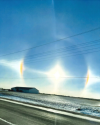
Photo Contest Winners
Photographs in this entry must be taken by the specific student and they must, in their own words, describe the physics in the image. Photographs must be in their original, unmodified or non-edited form.
Red Sunset
This image shows how light refracts at different wavelengths in the sky.
In the visible light part of the electromagnetic spectrum, violet and
blue have the shortest wavelengths while red has the longest wavelength.
The sky’s normal blue appearance is due to blue light waves scattering
in all directions and becoming absorbed by the molecules in Earth’s
atmosphere. Red, yellow, and orange lights with shorter wavelengths pass
through and are not scattered or absorbed. During sunrise and sunset,
the light from the sun has a farther distance to travel. By the time
the light reaches our eye, most of the blue light has been scattered
until the red, orange, and yellow light waves are left. When larger
molecules are in the sky such as rain clouds and dust, the longer
wavelengths will be absorbed. Therefore, when it is cloudy at sunset,
the sky tends to take on a vibrant red hue.
Reflections
I remember as a kid being curious of how two mirrors create more of the same reflections. But with these calculations, I had thought that a 360-degree angle divided by a 30-degree angle would equal 12 sections including 1 original & 11 images. But when I measured with a protractor, I figured out they are created by 360 degrees divided by 13 is equal to 27.7 degrees with 13 sections, 1 original and 12 images. Depending on where you place the object and where it stands. In the photo you will see that the object is placed in the front center of the angle, anything smaller than 180-degrees will cause more images to appear. What I’m showing as my object is three pennies on top of a bronzer sponge on a seasoning cap. The pink centerpiece would be the tape holding two mirrors together at a specific degree angle. If you look at the first two reflections right and left from the original image of the three pennies, the penny of Abraham Lincoln is reversed of him looking to the left. On the second set of the images, they are reflections of him facing back to the right like its original image. The remaining reflections alternate facing back and forth as they circle its way back around to the original image. It is a very interesting project and I’m hopeful you will think so too.


The Morning Dew
In the natural environment, people can find dew in their lawn or on the
leaves of their plants, nevertheless the dew is formed overnight. But
how is the dew created?
Well to explain, the dew is formed when water vapor in our atmosphere
condenses on cooler surfaces, it is about the same process as a bathroom
mirror while taking a shower. To explain, while someone takes a shower,
the air becomes warmer and then would come into contact with the
bathroom mirror. In any case, dew does not stay all day. It is based
upon the temperature. For instance, when the temperature drops, the rate
of condensation would exceed the rate of evaporation and water droplets
forms.
Overall, morning dew is formed from water vapor and condenses to the
colder surfaces, which is when people see them in the lawn or the leaves
on plants.
This photo depicts a reaction called a halo, specifically a circular halo or 22o halo. A halo is an absolutely breathtaking optical phenomena. A halo is an optical phenomenon which is made by sunlight or moonlight and ice crystals in the atmosphere. These beautiful phenomena can be seen when light reflects off the ice crystals. Halos can display colors in many different wavelengths. The rays can display a single color, a combination of colors, or the full color spectrum. In this image the halo rings have multiple colors which means the reflection process created a dispersion. This means that the white light has been split up to show the rainbow of colors. This photo was taken on Wednesday, January 10 of this year in Mitchell, South Dakota.
Water Vapor
When water is heated to 212° Fahrenheit, it reaches its boiling point
and starts to become water vapor. This water vapor rises off the liquid
because it is warmer than the air around it. Cold air cannot hold the
same amount of moisture as warm air. When taken outside on a cold day,
the water vapor cools rapidly when it touches the air. The vapor then
reaches the dew point, when air can no longer hold the moisture. When it
does so, it condenses once again to its liquid form, becoming minuscule
droplets of water that can be seen rising through the air. If the
temperature is cold enough, these droplets can freeze.